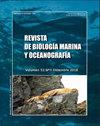Biomagnificación de mercurio en la cadena trófica del Delfín Moteado del Atlántico(Stenella frontalis), usando el isótopo estable de nitrógeno como marcador ecológico
IF 0.5
4区 生物学
Q4 MARINE & FRESHWATER BIOLOGY
引用次数: 12
Abstract
An assessment of mercury (Hg) concentrations and nitrogen stable isotope (15N) was conducted in the food chain of the Atlantic spotted dolphin (Stenella frontalis), including phytoplankton, zooplankton, planktivorous fish and its major prey (predatory fish and a single species of cephalopod), that compose a tropical trophic chain of the Brazilian southeastern coast. Tissue concentrations of Hg in a voracious predator fish, the largehead hairtail (Trichiurus lepturus), one of the dolphin’s prey, were 9.8 times lower than median concentrations found in dolphin tissues. 15N values in predatory fish were found to be lower to those of its predator the spotted dolphin. Isotopic data suggested significant differences for 15N along the trophic chain, with the top predator (dolphin) exhibiting heavier value, followed by the voracious predator fish and the benthonic carnivorous fish, the whitemouth croaker (Micropogonias furnieri). Phytoplankton displayed the lightest 15N, followed by zooplankton and the planktophagous fish, the lebranche mullet (Mugil liza). This fish species and the cephalopod showed the lowest median Hg concentration. All links of the entire trophic chain presented trophic transfer of Hg with a biomagnification factor higher than 1. A significant relationship was found between the log Hg concentration and trophic level (TL) of all evaluated species, with a positive slope (= 0.87). The calculated trophic magnification factor (TMF= 7.44) indicates that Hg concentration increased per TL, and also that the entire coastal food chain from the South Atlantic Ocean presented a biomagnification power of Hg within a range previously reported for tropical coastal ecosystems.利用氮的稳定同位素作为生态标记,对大西洋斑纹海豚(Stenella frontalis)食物链中的汞进行生物放大
汞浓度和氮稳定同位素的评估(15N)在大西洋斑点海豚(Stenella frontalis)的食物链中进行,包括浮游植物、浮游动物、浮游鱼类及其主要猎物(掠食性鱼类和一种头足类动物),它们构成了巴西东南海岸的热带营养链。海豚的猎物之一,贪婪的掠食性鱼类大头带鱼(Trichiurus lepturus)体内的汞组织浓度比海豚组织中的平均浓度低9.8倍。研究发现,掠食性鱼类的15N值低于其捕食者斑点海豚。同位素数据表明营养链上的15N,顶级捕食者(海豚)表现出更高的价值,其次是贪婪的食肉鱼类和底栖食肉鱼类白嘴黄鱼(Micropogonias furnieri)。浮游植物显示最轻15N,其次是浮游动物和浮游鱼类,lebranch mullet(Mugil liza)。这种鱼类和头足类动物的汞浓度中位数最低。整个营养链的所有环节都表现出汞的营养转移,其生物放大因子高于1。所有评估物种的log Hg浓度与营养水平(TL)之间存在显著关系,斜率为正(= 0.87)。计算的营养放大因子(TMF=7.44)表明,每个TL的汞浓度都有所增加,而且南大西洋的整个沿海食物链呈现出汞的生物放大能力,在之前报道的热带沿海生态系统的范围内。
本文章由计算机程序翻译,如有差异,请以英文原文为准。
求助全文
约1分钟内获得全文
求助全文
来源期刊
CiteScore
0.70
自引率
0.00%
发文量
41
审稿时长
12 months
期刊介绍:
Publicar desde una perspectiva científica, artículos originales, decididos por un proceso de revisión por pares, invitando a expertos de reconocido prestigio en el área. Los trabajos publicados se caracterizarán por su solidez teórica-metodológica, actualidad y relevancia para las ciencias marinas.
Se reciben trabajos inéditos derivados de la investigación científica realizada en ambientes marinos y estuarios, en formato de Revisión, Artículos, Notas Científicas, y Obituarios en las siguientes disciplinas::
Biología-Ecología marina
Oceanografía física, química y biológica
Contaminación marina
Geología marina
Sistemática, Faunística y Biogeografía Marina
Manejo Costero
Acuicultura marina
Pesquería marina.

 求助内容:
求助内容: 应助结果提醒方式:
应助结果提醒方式:


